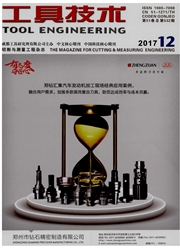

 中文摘要:
中文摘要:
针对目前大多数化学机械抛光(CMP)材料去除模型没有考虑到氧化薄膜作用的现象,提出一种考虑氧化后的芯片与磨粒之间的接触模型,该模型的建立基于接触力学理论和接触微凸体由弹性变形向弹塑性变形及最终向完全塑性变形的转化过程,并将该模型与传统的塑性去除模型进行了对比分析。结果表明:低压CMP精抛过程中,磨粒在外载荷的作用与氧化后的芯片表面发生接触去除,且随着工作载荷的增大,芯片表面的压痕深度、卸载回弹量、最大应力和材料去除量也随之增大;当载荷为1200-4250n N时,芯片弹塑性接触去除率小于传统理想塑性接触去除率;当载荷约为1650n N时,相对误差达到最大值28%。因此,氧化后的芯片与磨粒并非简单的塑性去除,考虑氧化后的芯片去除将更有利于后续精确地统计实际CMP去除率,为进一步优化CMP工艺提供一定的理论基础。
 英文摘要:
英文摘要:
Most current chemical mechanical polishing( CMP) material removal models do not account for the role of oxide films. A contact model between the oxide chip and the wear particle is proposed based on the contact mechanics theory. The transformation process of elastic deformation and plastic deformation of the contact micro convex body is made of elastic deformation,and the model is compared with the traditional plastic removal model. The results show that: the role of the abrasive grains in the process of the low pressure CMP is removed from the surface of the chip after the oxidation. With the increase of the working load,the indentation depth,the amount of resilience,the maximum stress and the material removal rate of the chip surface are increasing. When the load is between 1200 n N and 4250 n N,the plastic contact removal rate of the chip is less than that of the traditional ideal plastic contact removal rate. And when the load is about 1650 n N,the relative error reaches a maximum of 28%. Thus,the oxidized chip and the abrasive grains are not simply removed by plastic. After considering the oxide chip removal will be more conducive to the subsequent accurate statistical analysis of the actual CMP removal rate,which could provides a theoretical basis for the further optimization of CMP process.
 同期刊论文项目
同期刊论文项目
 同项目期刊论文
同项目期刊论文
 Analysis of plastic strain versus different depth between two fractal surfaces under different defor
Analysis of plastic strain versus different depth between two fractal surfaces under different defor The influence of velocity variation on the adhesive contact behavior and the deformation of substrat
The influence of velocity variation on the adhesive contact behavior and the deformation of substrat 期刊信息
期刊信息
